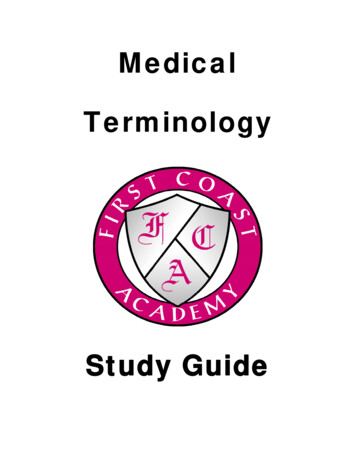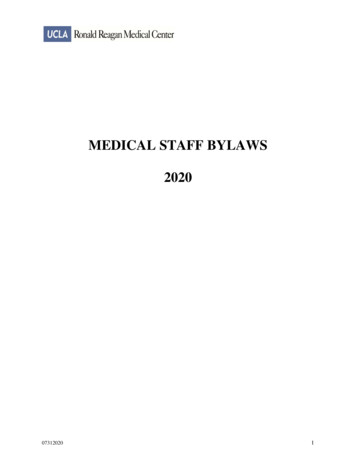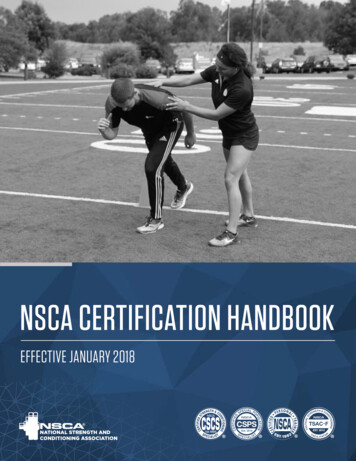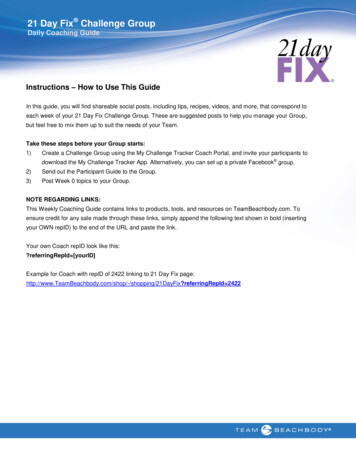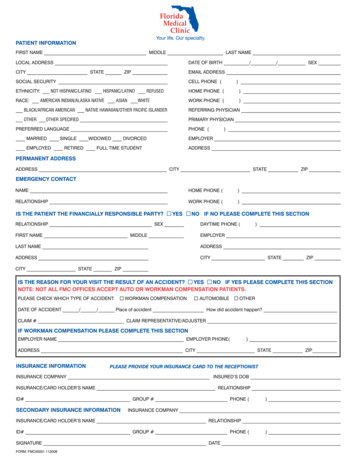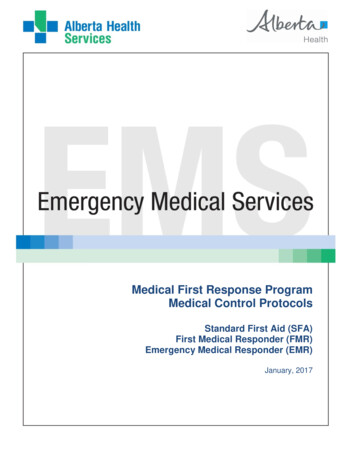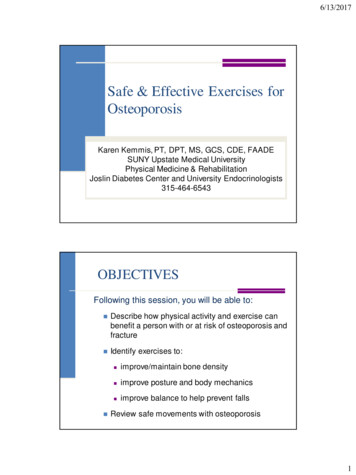
Transcription
6/13/2017Safe & Effective Exercises forOsteoporosisKaren Kemmis, PT, DPT, MS, GCS, CDE, FAADESUNY Upstate Medical UniversityPhysical Medicine & RehabilitationJoslin Diabetes Center and University Endocrinologists315-464-6543OBJECTIVESFollowing this session, you will be able to: Describe how physical activity and exercise canbenefit a person with or at risk of osteoporosis andfracture Identify exercises to: improve/maintain bone density improve posture and body mechanics improve balance to help prevent fallsReview safe movements with osteoporosis1
6/13/2017HANDOUTSSeveral handouts will be available: Important facts Ways to improve bone health Prevent falls Calcium-rich foods Bone basics: Who gets osteoporosis Bone basics: Vertebral fracturesOverview of Osteoporosis Affects 53 million Americans10 million have osteoporosis 43 million have low bone mass (Clinician’s Guide to the Prevention and Treatment ofOsteoporosis, NOF, 2014)More than 2 million men have osteoporosis Osteoporosis is responsible for 2 million fractureseach year 2
6/13/2017Osteoporosis Can Cause Any Bone toBreak The 3 most common sites forfractures: Spine Wrist HipThe Risk of Breaking a BoneA Serious Healthcare Threat 1 out of 2 women aged 50 yrs 1 out of 4 White men aged 50 yrs Men suffer fewer fractures, but have twice the 1-yrmortality compared to women(Clinician’s Guide to the Prevention and Treatment of Osteoporosis, NOF, 2014)3
6/13/2017Osteoporosis is a Silent Disease You can’t see or feel your bones gettingthinnerLifestyle Changes to Reduce Fractures Exercise Calcium Vitamin D Don’t smoke Don’t drink too much Medications if indicated(Clinician’s Guide to the Prevention andTreatment of Osteoporosis, NOF,2014)4
6/13/2017Exercise and Physical Activity forBone HealthWhat Types of Exercise Improve BoneHealth?Several types of exercises are important forbone health, including those that: Make bones stronger Improve posture and body mechanics Improve balance to help prevent falls5
6/13/2017EXERCISE AND BONEDENSITY/STRENGTHWhat Types of Exercise Make BonesStronger?Two types of exercises that improve bonestrength are:Weight-bearing exercises which make youwork against gravity while being upright, suchas brisk walking. Muscle-strengthening exercises which makeyou move your body, a weight or some otherresistance against gravity, such as liftingweights; also called resistance exercises. 6
6/13/2017What Can You Expect for Change?Some Examples of Weight-bearingExercisesHigh-impact exercises: Dancing High-impactaerobics Hiking Jogging/running Jumping Rope Stair climbing Tennis VolleyballLow-impact exercises: Elliptical trainingmachines Stair-step machines Low impact aerobics Walking on atreadmill Walking on levelsurfaces (such asmall walking oroutdoors)7
6/13/2017Weight-bearing ExercisesHow Much Weight-bearing ExerciseShould You Do? Children and adolescents: 60 minutes ofmoderate to vigorous activity every day,including high-impact activities Adults: 150 minutes per week of moderate or75 minutes per week of vigorous activity,including impact activities; based on yourhealth and abilities Older adults: Follow adult guidelines, adaptedas needed based on your health8
6/13/2017What are Some Examples of Musclestrengthening Exercises?Muscle-strengthening exercises can be done: With weight machines With hand and ankle weights With elastic exercise bands By moving against gravityHow Much Muscle-strengtheningExercise Should You Do?The recommendations for strengtheningexercises are: 2-3 days per week; 1-3 sets of 8-12exercises, including all major muscle groups Hard enough to cause fatigue by 8-10repetitions (or 15-20 repetitions of a lighterweight if you are frail or are at risk of afracture)Muscle-strengthening exercises shouldalways be done with proper form9
6/13/2017POSTURE AND BONE HEALTHPosture and Body Mechanics Good posture and proper body mechanicsare important to decrease your risk of spinefractures10
6/13/2017Spine Fractures May Cause: Pain Loss of height Stooped posture Difficulty breathing Stomach pains or digestivediscomfort Loss of self-esteemHow is Your ww.trainawaythepain.com/postures.jpg11
6/13/2017Posture and Body Mechanics You may need to see a physicaltherapist to examine yourposture and body mechanics;he/she can prescribed specificexercises for you Posture exercises can be donefor a few minutes several timesduring the dayGreat Exercises Lengthen the neck: Tilt breastbone up, lift head upand back, hold for 5-10 seconds, do 2-4 repetitions This can be done sitting, lying down, standing, oron your car headrest during stop lights!1212
6/13/2017Great Exercises Pectoral Stretch: Stand facing corner or in adoorway, step into a lunge, forearms/hands onwall, elbows below shoulder level, slowly lean toget a stretch on the front of your shoulders, hold for30 seconds, do 1-2 repetitionsGreat Exercises Abdominal isometric strengthening: Lie in acomfortable position, head on the floor/bed/pillow Pull your navel in, lift one knee toward chest as thehand pushes it away, hold 2 seconds, relax butkeep your knee up then repeat 5-10 times eachside and 5-10 crossing hand to opposite knee13
6/13/2017FALLS AND FRACTURESFalls and Fractures More than 1/3 adults, age 65 yrs, fall eachyear Fall-related injuries are the leading causeinjury deaths and disabilities in older adults Most fractures in older adults result from a fall Most serious injury is hip fracture 90% of hip fractures are the direct result of afall(CDC Recommendations and Reports, 2000)14
6/13/2017Hip Fractures have SeriousConsequences Usually requires surgery 1 in 5 need a skilled nursingfacility within a year 1 in 4 become disabled Many become isolated anddepressed 1 in 5 die within a year of thefractureRisk Factors for Falls Increasing age Muscle weakness Functional limitations Environmental hazards Use of psychoactivemedications History of falls15
6/13/2017Balance and Falls A complete balanceassessment may include areview of your medications, avision exam, a safety check ofyour home, and tests of yourstrength, flexibility, posture andbalanceHow Good is Your Balance?One-leg Stance Test Stand on dominant foot, arms foldedacross chest, barefoot, eyes open How long can you stay without: Stepping with your standing foot? Touching the raised foot to theground? Using the lifted leg to support theweight bearing limb? Moving your arms out of position?16
6/13/2017Let’s do it!Incorrect FormCorrect FormOne-leg Stance NormsAgeEyesTime in Seconds20-29Opened30.0Closed28.8 (2.3)Opened30.0Closed27.8 (5.0)Opened29.7 (1.3)Closed24.2 (8.4)Opened29.4 (2.9)Closed21.0 (9.5)Opened22.5 (8.6)Closed10.2 (8.6)Opened14.2 (9.3)Closed4.3 (3.0)30-3940-4950-5960-6970-7917
6/13/2017How is Your Dynamic Balance?Tandem Walk Test Try to walk heel-to-toe along a 2 inchwide line/floor board Your heel and toe should touch oralmost touch Count the steps you manage beforeyou: Touch a foot to the floor before properplacementDon’t touch heel to toeMiss the lineReach 20 steps (Yeah!) Should be able to complete 20 stepswithin 3 trialsBALANCE TO PREVENT FALLS18
6/13/2017Balance Exercises Balance can be improved withexercises for leg strengtheningand stretching, challengingbalance exercises, and with taichi Balance exercises can be donefor a few minutes each day Balance exercises are veryimportant for older adults and allwho have balance problemsBalance ExercisesPositions for feet:Wide stanceNormal stanceNarrow stanceWide semi-tandem Semi-tandem Tight semi-tandemFull tandemSingle limb, other foot in the air19
6/13/2017Balance Exercises For safety, stand with back to a corner or near a sink (hands hovering in)Stand heel to toeStand on one leg Then do it on a pillow Or with your eyes closedWalk heel to toe down the hallDo crossoversYou should feel wobbly but not as if youcould lose your balance or fallDo leg strengthening exercisesSAFETY IN EXERCISE ANDMOVEMENTSPilates and OsteoporosisLiverpool LibraryMonday, June 19 at 6-7 p.m.20
6/13/2017Safe Movement Some movements and exercises may beunsafe if you have low bone density orosteoporosis You should avoid: spine flexion full spine rotation strenuous overhead lifts activities that increase risk of a fallSafe Movement Some examples of spine flexion are: Curlsit-ups Toe touches and bending to the floorAVOID!21
6/13/2017Safe Movement An example of full spine rotation is: The extreme twist at the beginning and end ofa golf swing if you have had fractures or arefrail Work with a professional to determine what isright for youAVOID!Safe Movement Some examples of strenuous overhead liftingare: When lifting heavy weights When lifting something heavy into a topcupboard/overhead in a plane When lifting babies/children overhead Work with a professional to determine what isright for you22
6/13/2017Safe Movement Some examples of activities that increase risk ofa fall are: Downhill skiingWalking on iceWalking on wet floorsRollerbladingPUTTING IT ALL TOGETHER23
6/13/2017The Exercise Prescription Weight-bearing exercises can be done for 30minutes, most days of the week; focus onimpact Muscle-strengthening exercises should bedone 2-3 times per week, proper form Balance exercises and posture exercises canbe done for a few minutes each day You may choose to do exercises that aremost important to youWorking with a Healthcare Professional Consider working with your healthcareprofessional if:You are not sure of the exercise program thatis best for you You have had a fracture You have fallen recently You have pain that prevents exercise 24
a golf swing if you have had fractures or are frail Work with a professional to determine what is right for you AVOID! Safe Movement Some examples of strenuous overhead lifting are: When lifting heavy weights When lifting something heavy into a top cupboard/overhead in a plane When lifting babies/children overhead


